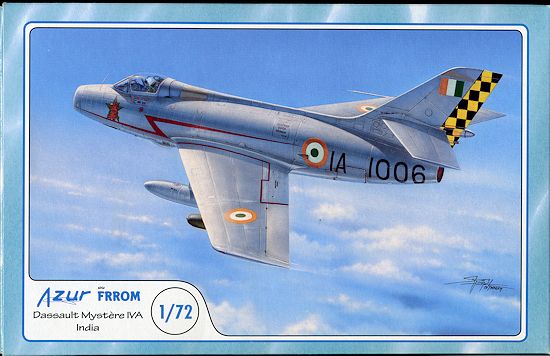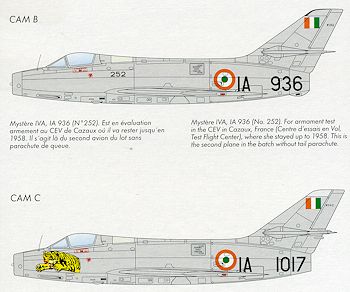
Azur/Frrom 1/72 Mystere IVa: India
| KIT #: | FR022 |
| PRICE: | $25.00 from www.westcoasthobbys.com |
| DECALS: | Three options |
| REVIEWER: | Scott Van Aken |
| NOTES: | Short run kit with resin and photo etch parts |

| HISTORY |
India procured 104 of aircraft in 1957 and it was used extensively in the Indo-Pakistani War of 1965. On 16 Sept 65 a Mystere IVA shot down a Pakistani L-19. On 7 September 1965 an Indian Mystere shot down a Pakistani Lockheed F-104 Starfighter in a raid over Sargoda. The Mystere pilot Devayya was later awarded the Maha Vir Chakra posthumously 23 years after the battle. During the campaign Mystère IVs also destroyed Pakistani aircraft on the ground including four F-86F, three F-104 and 2 Lockheed C-130 Hercules transports.
The phasing out of the aircraft as a fighter started soon after the 1965 Indo-Pakistani War; though it saw further action as a ground attack aircraft in the Indo-Pakistani War of 1971. It was completely phased out of the Indian Air Force by 1973.
| THE KIT |
 One of
the MPM/Special Hobby/Azur family of kits, this is one of three different and I
would suspect nearly identical boxings of the Mystere IVa that have recently
been released. This one concentrates on the Indian aircraft with the others
leaning towards the French and Israeli aircraft. As such, I would expect there
to be little that is different aside from decals.
One of
the MPM/Special Hobby/Azur family of kits, this is one of three different and I
would suspect nearly identical boxings of the Mystere IVa that have recently
been released. This one concentrates on the Indian aircraft with the others
leaning towards the French and Israeli aircraft. As such, I would expect there
to be little that is different aside from decals.
As this is a multi-media kit, there is a small etched
fret and a small bag of resin bits. The plastic itself is very nicely detailed
and has a sort of rough feel to it, like fine sandpaper. This is not unusual for
short run kits and does not detract from the building or painting of the model.
There are a few parts not used in this kit, the main ones being a separate set
of horizontal stabs without elevators, used on those aircraft with a 'flying
tail'. The Indian version uses the ones with the elevators.

The basic kit is relatively simple as these kits go. The cockpit is built up of a floor, side walls and fore and aft bulkheads. Much of the interior is where one uses some of the resin (the bang seat) and a goodly amount of the photo etch (instrument panel, harness, rudder pedals, control knobs). The rest of the photo etch is used for oleo scissors and a radio mast.
Regarding the rest of the resin parts, they are used for the exhaust, wheels, and for a couple of bits on the rear. Specifically a tail bumper that is only used for one option and the braking parachute housing used on the other two. A gun sight and a few other small bits complete the resin. The clear pieces are well done and consist of a landing light as well as a separate windscreen and canopy. The canopy is shown as being built closed as there is no mechanism included in the kit.
I found it interesting that there are intake ducts
that are included in the kit to be capped by the splitter. Of course, doing this
way really limits where you can put nose weight as, though not shown, I am
pretty sure this one will need some. The nose gear well is incorporated with the
cockpit assembly while the center part of the main well is built up of four
sections and installed prior to closing the fuselage halves. The wings are a
single piece on each side. Gear is well detailed with center doors shown closed
as the y
should be.
y
should be.
Markings are for three planes. One is the box art
plane with 8 Squadron in 1965. T he
second is the one retained in France for weapons trials so has no unique
markings. This plane has no braking chute housing and has the tail bumper. The
third has a large tiger's head and was assigned to 1 Squadron in 1965. This unit
took part in the 1965 war and was the first Mystere IV unit to attack a PAF
airfield. All planes are unpainted metal. The decals are very well printed and
are probably quite thin. Those seeking aftermarket will find some, but they are
few and far between. Instructions are well done with the usual Gunze paint
references.
he
second is the one retained in France for weapons trials so has no unique
markings. This plane has no braking chute housing and has the tail bumper. The
third has a large tiger's head and was assigned to 1 Squadron in 1965. This unit
took part in the 1965 war and was the first Mystere IV unit to attack a PAF
airfield. All planes are unpainted metal. The decals are very well printed and
are probably quite thin. Those seeking aftermarket will find some, but they are
few and far between. Instructions are well done with the usual Gunze paint
references.
| CONCLUSIONS |
It is a delight to see this important French jet done properly in 1/72. Before this there was only the rather basic Matchbox kit to serve the injected plastic crowd while in 1/48, there was the rather more difficult to build F.M. kit, which your editor managed to cobble together. Any collection of French planes should have this one added to it.
| REFERENCES |
http://en.wikipedia.org/wiki/Mystere_IV
February 2013
Thanks to West Coast Hobbys for the preview kit. Get yours at the link.
If you would like your product reviewed fairly and fairly quickly, please contact the editor or see other details in the Note to Contributors.